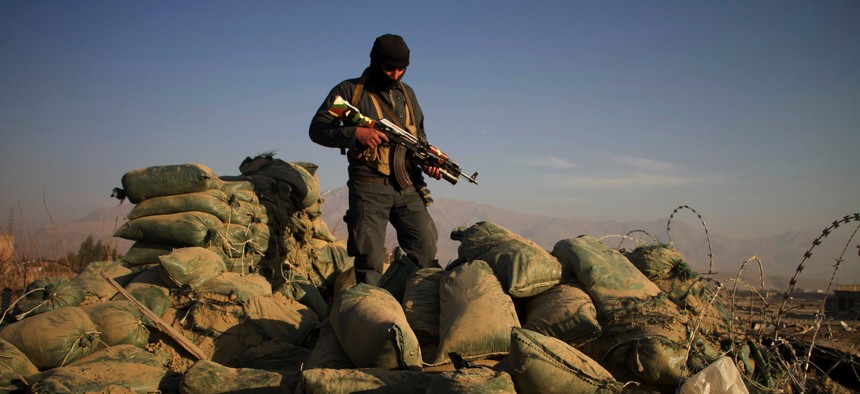
An Afghan security force member stands at the site of a car bomb explosion in Khogiani district of the eastern Nangarhar province, Afghanistan, Feb. 7, 2021. Photo by Saifurhaman Safi/Xinhua via Getty
How many U.S. troops are in Afghanistan, and what is their mission?
There are currently 2,500 U.S. troops in Afghanistan, along with 6,346 U.S. contractors [PDF]. U.S. force levels peaked at 100,000 in 2011. Under a withdrawal agreement [PDF] signed by the Donald J. Trump administration and the Taliban in February 2020, there should be no U.S. troops left in Afghanistan by May 1.
Some of the remaining U.S. troops conduct Special Operations missions with Afghan partner forces against international terrorist organizations including al-Qaeda and the self-proclaimed Islamic State. The rest train, advise, and assist Afghan security forces as part of the North Atlantic Treaty Organization’s (NATO) Operation Resolute Support. For the first time ever, there are more allied troops in Afghanistan (about eight thousand) than U.S. forces there. While small in number, U.S. personnel still provide important functions, including intelligence and air support for Afghan forces. The United States also provides Afghanistan with a critical $4.8 billion in assistance per year, which funds 80 percent [PDF] of the Afghan government’s security expenditures.
What has the Biden administration said about the May deadline?
On Jan. 28, Pentagon spokesperson John Kirby said that “the Taliban have not met their commitments,” casting doubt on whether U.S. forces will exit by May 1. No final decision has been made.
According to the U.S.-Taliban agreement, a complete U.S. withdrawal is conditional on the Taliban’s break with international terrorist organizations, such as al-Qaeda, and on its prevention of activities on Afghan soil that “threaten the security of the United States and its allies.” The Afghanistan Study Group, a blue-ribbon panel appointed by the U.S. Institute of Peace, said in a new report that the Taliban also promised U.S. negotiators that it would not attack “international forces, large Afghan cities, and some other targets.”
However, the Taliban has not disavowed al-Qaeda; indeed, the United Nations reports that relations between the two are as close as ever. And although the Taliban has refrained from attacking U.S. forces, it has escalated attacks against Afghan security forces and civilians.
What are President Biden’s options?
Biden has three options:
- Withdraw U.S. forces as scheduled by May 1;
- Cite Taliban violations as justification for pulling out of the accord and maintaining an indefinite U.S. military presence; or,
- Ask the Taliban for an extension of the withdrawal deadline, citing the Taliban’s violations and delays in peace talks between the militant group and the Afghan government.
What is he likely to do?
The Afghanistan Study Group, co-chaired by retired general Joseph F. Dunford, Jr., a former chairman of the Joint Chiefs of Staff, summed up the risks well: “On the one hand, the Taliban have signaled publicly that if all international forces are not withdrawn by May 2021, as envisioned in the Doha agreement, they will resume their ‘jihad’ against the foreign presence and will withdraw from the peace process. On the other hand, a withdrawal in May under current conditions will likely lead to a collapse of the Afghan state and a possible renewed civil war.” The study group warns that “a precipitous withdrawal could lead to a reconstitution of the terrorist threat to the U.S. homeland within eighteen months to three years.”
Given the risks of options one and two, Biden is likely to opt for number three: trying to win Taliban support for extending the withdrawal deadline while intra-Afghan peace talks continue. The Biden administration is likely to ask other countries, including China, Iran, Pakistan, Qatar, Russia, and Saudi Arabia, to pressure the Taliban into amending the agreement.
If the Taliban doesn’t agree to an extension (the odds are that it won’t), the Biden administration will be left with the unpalatable choices of pulling out anyway—risking a collapse of the Afghan state—or remaining embroiled in the “forever war.” The administration is likely to maintain at least 2,500 troops while insisting that the United States is committed to withdrawal and supports the peace process. (The Afghanistan Study Group recommends increasing that number of troops to 4,500.) The Taliban is likely to call this a betrayal of the agreement and respond by targeting U.S. and other international forces to try to raise public pressure in the West for their removal. But if the Taliban fails to achieve its goals through these tactics, it could eventually return to the negotiating table.
This piece, first published by the Council on Foreign Relations, is used with permission.




